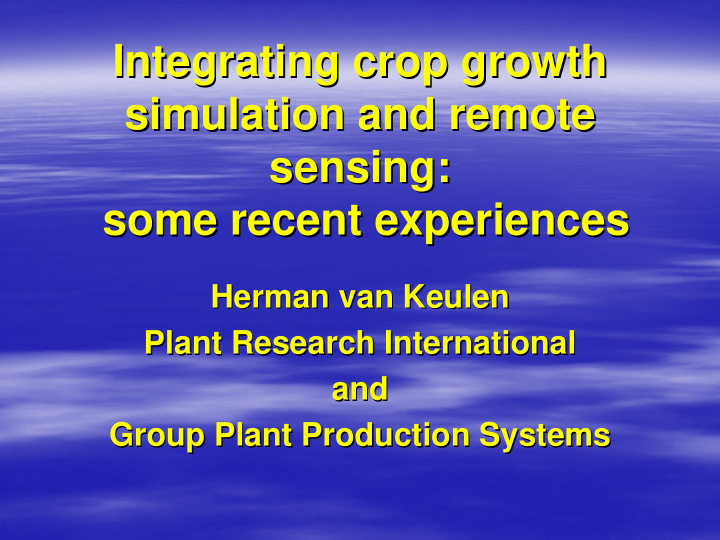



Integrating crop growth Integrating crop growth simulation and remote simulation and remote sensing: sensing: some recent experiences some recent experiences Herman van Keulen Herman van Keulen Plant Research International Plant Research International and and Group Plant Production Systems Group Plant Production Systems
Presentation largely based on: Integrating crop growth simulation Integrating crop growth simulation and remote sensing and remote sensing to improve resource use efficiency to improve resource use efficiency in farming systems in farming systems Raymond Jongschaap Raymond Jongschaap
AN EXPERIENCE AN EXPERIENCE Predicting wheat production at Predicting wheat production at regional scale by integration regional scale by integration of remote sensing data with a of remote sensing data with a simulation model simulation model
METHODOLOGY METHODOLOGY 1. Optical remote sensing data (SPOT Optical remote sensing data (SPOT 1. HRV XS and Landsat Landsat 5 TM) to 5 TM) to locate locate HRV XS and winter wheat crops in the region winter wheat crops in the region WHEAT GRASS GREEN IN WINTER GREEN IN LATE SUMMER - - NDVI NDVI
METHODOLOGY METHODOLOGY 2. Radar remote sensing data (ERS Radar remote sensing data (ERS- -SAR SAR 2. C- -band) to band) to determine determine wheat wheat flowering flowering C dates for the region dates for the region MOISTURE IN MOISTURE IN 550 GROWING CROP GROWING CROP 500 ‘MASKS MASKS’ ’ RADAR SIGNAL RADAR SIGNAL ‘ 450 DN Value 400 FROM SOIL FROM SOIL 350 April 12th, 1997 300 DURING RIPENING DURING RIPENING 250 FLOWERING 200 RADAR SIGNAL OF RADAR SIGNAL OF 1-Dec-96 20-Jan-97 11-Mar-97 30-Apr-97 19-Jun-97 8-Aug-97 27-Sep-97 SOIL RE RE- -APPEARS APPEARS Date SOIL RADAR SIGNALS IN TIME
METHODOLOGY METHODOLOGY 3. Field observations from pilot areas to Field observations from pilot areas to 3. calibrate a a wheat growth model wheat growth model to local to local calibrate conditions conditions 4. Flowering dates Flowering dates combined with regional combined with regional 4. soil data to extrapolate the simulation the simulation soil data to extrapolate model from from a a point point- -based based to to a a regional regional model application application
METHODOLOGY METHODOLOGY 5. Potential and sub Potential and sub- -optimal conditions for optimal conditions for 5. wheat growth are assumed to determine determine wheat growth are assumed to the yield gap, the difference between , the difference between the yield gap (simulated) potential and (simulated and (simulated) potential and (simulated and observed) actual production observed) actual production Scenario Soil Area Yield Production (P) Regional type (ha) (t ha -1 ) (t) production (t) 1 Potential - 3000 11.35 (1.02) 34050 34050 2 Water-limited 1 2700 6.08 (0.51) 16416 17997 2 300 5.27 (0.39) 1581 3 Water- and nitrogen- 1 2700 4.70 (0.28) 12690 13947 limited 2 300 4.19 (0.21) 1257
METHODOLOGY METHODOLOGY 6. Actual Actual production statistics production statistics from the from the 6. production region are used to evaluate evaluate production region are used to simulation results. simulation results. SIMULATED Department Region Total Production Area Yield (t) (ha) (t ha -1 ) SOIL1/SOIL2 5.84/5.02 82 Midi-Pyrénées ( MP ) 540600 104400 5.18 83 Provence Alpes-Côte d’Azur ( PAC ) 518500 98100 5.29 4.53/4.05
ANOTHER EXPERIENCE ANOTHER EXPERIENCE CANOPY GROWTH RATE SOIL EVAPORATION TIME Run- -time calibration of simulation time calibration of simulation Run models by integrating remote models by integrating remote sensing estimates of leaf area index sensing estimates of leaf area index and canopy nitrogen and canopy nitrogen
TRANSLATION TRANSLATION � Relation Relation between between � sensor- -information information sensor Reflectie (%) and important and important vegetation vegetation characteristics characteristics Golflengte (nm) Vegetation Index Index Crop Crop characteristic characteristic Vegetation NDVI Green plant material material NDVI Green plant WDVI Leaf area area (index) (index) WDVI Leaf λ REP λ REP Chlorophyll/ /Nitrogen Nitrogen Chlorophyll content content
CROP CHARACTERISTICS CROP CHARACTERISTICS OBSERVATIONS/ /BASE RUN BASE RUN OBSERVATIONS SIMULATED AND MEASURED LAI SIMULATED AND MEASURED CANOPY NITROGEN
RESETTING SIMULATION RESETTING SIMULATION VALUES VALUES THE SMALLER THE BETTER ROOT MEAN SQUARE ERROR Scenario Integration a) Leaf area index Canopy nitrogen Soil inorganic nitrogen LAI Ncan % Sn (n=40) (n=34) (n=27) BASE 0 - - - - 0.84 (100) 13.7 (100) 30.4 (100) RUN 1 + - - - 0.61 (73) 12.2 (89) 24.1 (79) 2 - + - - 0.86 (102) 12.0 (88) 33.3 (110) 3 + + - - 0.61 (73) 12.0 (88) 26.0 (86) 4 + - - + 0.61 (73) 12.2 (89) 24.2 (80) 5 - + - + 0.85 (101) 12.0 (88) 34.7 (114) 6 + + - + 0.61 (73) 12.0 (88) 29.3 (96) 7 + - + - 0.61 (73) 12.7 (93) 23.3 (77) 8 - + + - 0.85 (101) 12.0 (88) 33.3 (110) 9 + + + - 0.61 (73) 12.0 (88) 24.9 (82) 10 + - + + 0.61 (73) 12.7 (93) 23.3 (77) 11 - + + + 0.85 (101) 12.0 (88) 34.7 (114) 12 + + + + 0.61 (73) 12.0 (88) 28.9 (95) INTERNAL ADJUSTMENT MODEL
CONCLUSION CONCLUSION introduction of field field- -based remote based remote introduction of sensing observations for for run run- -time time sensing observations adjustment of dynamic crop growth of dynamic crop growth adjustment simulation models enhances enhances simulation simulation simulation models accuracy of important variables (such as of important variables (such as accuracy LAI, canopy nitrogen status and soil LAI, canopy nitrogen status and soil inorganic nitrogen content) ) inorganic nitrogen content
HOWEVER… ….. .. HOWEVER ACQUISITION OF SUCH INFORMATION IS ACQUISITION OF SUCH INFORMATION IS TIME- -CONSUMING CONSUMING TIME LABORIOUS LABORIOUS UNCERTAIN UNCERTAIN
WE MOVE FORWARD FORWARD, BUT , BUT SLOWLY SLOWLY… … WE MOVE
Recommend
More recommend